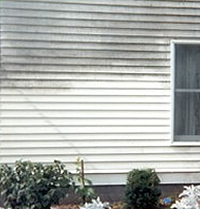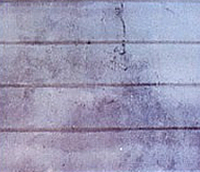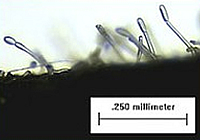Warning: There May Be A Fungus Eating Your House!
What To Do About The Mildew
Problem
What you don't know could be hurting your house or your commercial building. Especially in the Northwest, with the mild climate and year-round moisture, mildew is a common problem.
"Mildew" is often used interchangeably with the word "mold". They are the generic terms that describe a variety of microorganisms, including fungi, algae, rusts, yeasts, and bacteria, that are agents of deterioration. Mildew is a form of plant life that feeds on organic matter and grows on surfaces as a discoloration resembling dirt, usually a black, brown or gray color in irregular, mottled patterns. They produce stains that can permanently damage a surface or object.
Mildew is not paint or stain failure. Rather, mildew feeds on oil or nutrients found on various surfaces exposed to moisture. Mildew spores are wind borne; one infected house in a neighborhood can provide sufficient spores to contaminate many others. Moisture and warmth are the most important factors in the growth of mildew, which can lie dormant for years if kept dry.
Home Maintenance Can Prevent Mildew
There are steps that can be taken to reduce the chance of mildew forming. It is best to repaint in a dry season. Thick shrubbery in front of the area can block out sunlight, allowing dampness to create a mildew-growing environment. Keeping shrubbery thinned is helpful.
In addition, use exterior paints, stains and primers that contain mildewcides — a chemical agent which helps retard the growth of mildew on paint and stain films. Remember, always apply paints and stains at the manufacturer's recommended spread rate. If the paint is watered down or spread too thin (as is the case with some painting companies), the mildewcide may not kill the microorganisms.
Mildew Removal Instructions
To remove mildew, scrub the affected areas with a solution of 50% household bleach and 50% water by volume. A commercially available mildewcide can also be used. (Caution: Follow manufacturer's instructions when using cleaning agents. Use protective gloves and goggles.) Additional treatments may be required depending on the severity of the mildew damage. Rinse completely with water to remove any surface residue. The surface must dry completely before proceeding with further preparation or painting.
Paint as soon as possible with a mildew-resistant primer, paint or stain. Preservative Paint™ products designed for use in mildew-prone areas contain a very effective mildewcide. Additional biocides (available at Preservative Paint) may also be added to improve mildew resistance.
There is no guarantee that a paint or stain film can be "mildewproof" because there are so many different types of fungi. When mildew is present, kill and remove all existing spores before painting new surfaces or repainting. Never paint over existing mildew. Mildew can grow under a fresh coat of paint leading to paint failure and peeling.
Recommended Experts in Mildew Cleanup, Painting
Preserve and protect your house or building by contacting Northwest Quality Painting now for a free mildew inspection. You'll learn what you can do to remove mildew, repair mildew damage, and prevent mildew from returning.
Information compiled from Preservative Paint Company's Technical Service Department, NDPA, ASM, APA, NPCA and the Pacific Northwest Society For Coatings Technology.
For additional information:
- Call the Customer Service Department at Preservative Paint Company: 800-669-1015
- Read more on the website for the Environmental Protection Agency: https://www.epa.gov/iaq/molds/moldguide.html
- Download a free report: "How to Choose a Painting Contractor"
- Get a complimentary mildew inspection from Northwest Quality Painting.




